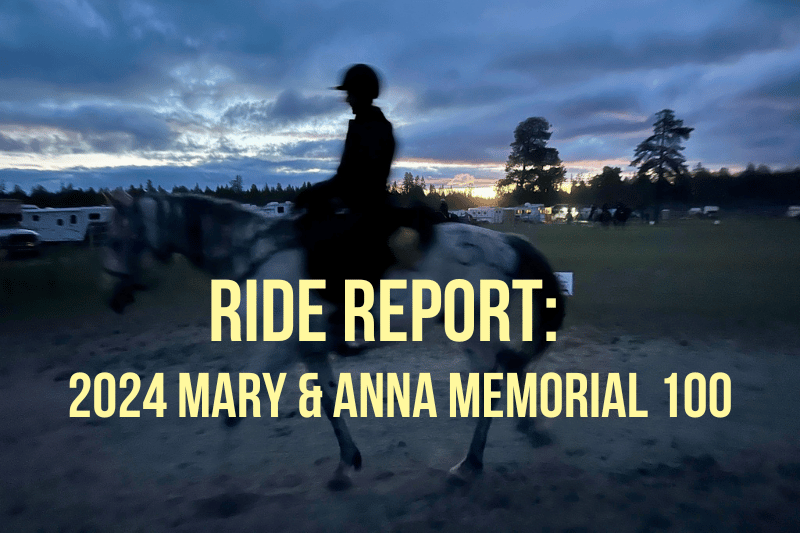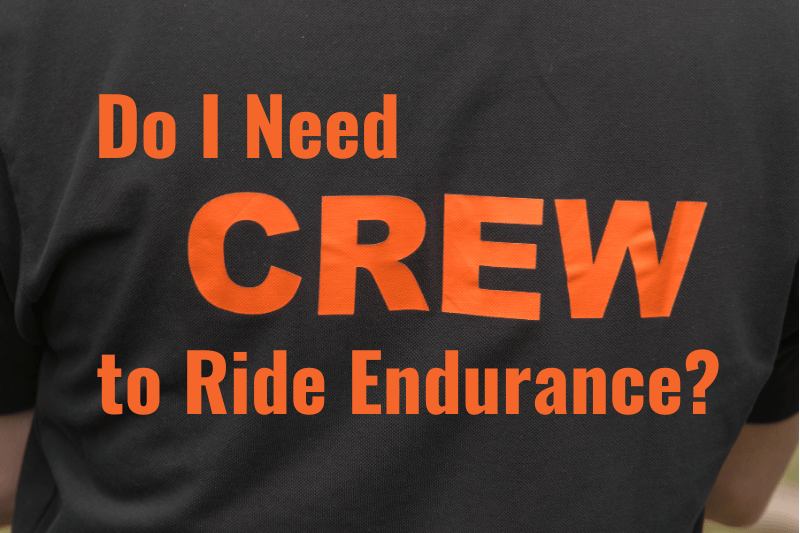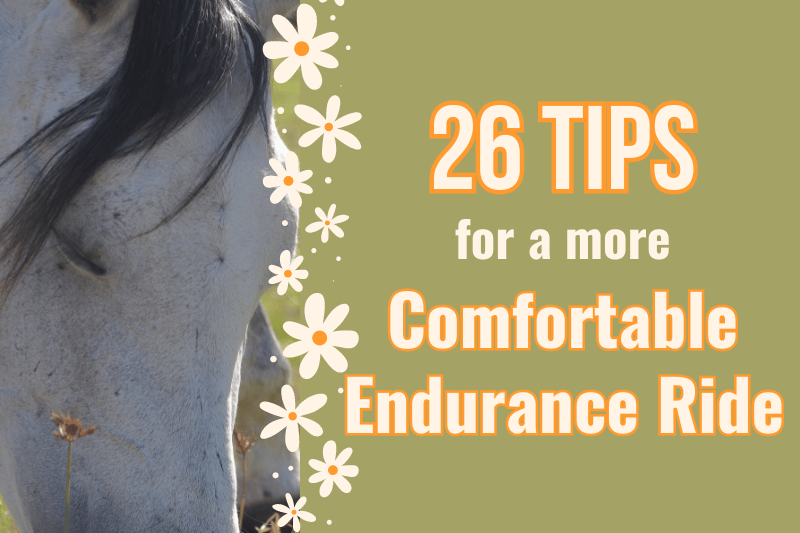In central Oregon, just above the jagged border where sageland rises into timber, Outback Station nestles among the trees. This ranch has served as camp for many endurance rides in recent decades. Yet somehow, even though it’s only about a 7-hour haul from my own farm, I’d never been there.
Now, it was time.
Mr. Sweaty and I wound our way across the map with Atlas in tow. I’d ridden him just four times since taking over his season after his and Layne’s accident at the start of Eagle Canyon. This was to be his first endurance ride of 2024, our major fitness boost ahead of Tevis, and my first 100 in nine years.
Nine years!
It wasn’t for lack of wanting. If I’d had my way, I would have ridden several hundreds every year for the past decade. Reality had other plans: Freak diagnoses and drug reactions among my horses. A house fire. A broken back. I came close to giving up on endurance because, year after year, I just couldn’t pull the pieces together.
Finally, I accepted that I might not see another amazing season. I rediscovered the joy of simply riding, and of taking the time to get a new mare “fancy broke.” I also kept chipping away at endurance, curious instead of anxious, to see what time might bring.
Now Atlas and I were pulling into the same parking spot Layne had occupied last year, awash with excitement and gratitude. Although the circumstances were far from ideal – I wouldn’t have sacrificed my great friend’s leg for it! – this was the opportunity I’d daydreamed about for years.
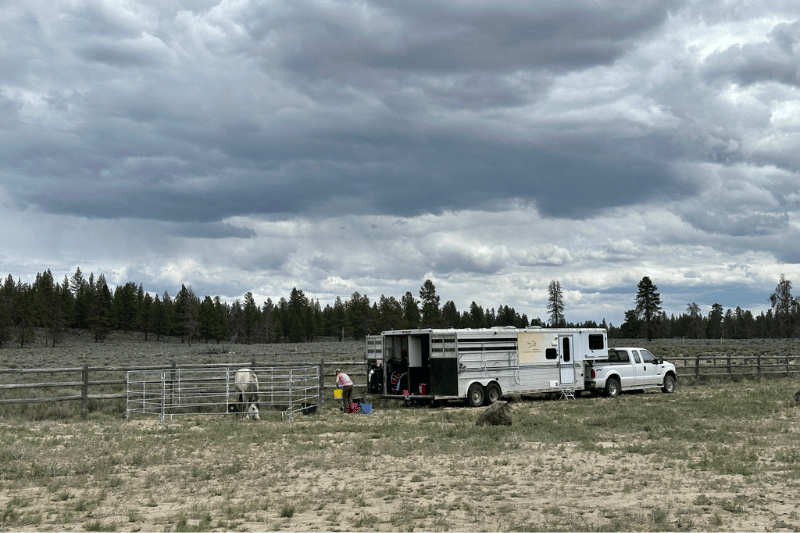
Atlas hopped off the trailer and surveyed camp like a pro. Though only 8 years old, with just 9 rides on his record (not counting the ill-fated start at Eagle Canyon), he didn’t waste time gawking. No, Atlas calmly dropped his head and dispatched the nearest clump of grass. Then, he sucked down a bucket of water.
I spent the next few hours on logistics: registration, vetting (all A’s), attaching my headlamp to my helmet and glowsticks to Atlas’ breastcollar. It always feels like an optimistic move to assume you’ll still be riding by nightfall, but thinking several steps ahead is one of the keys to an enjoyable ride.
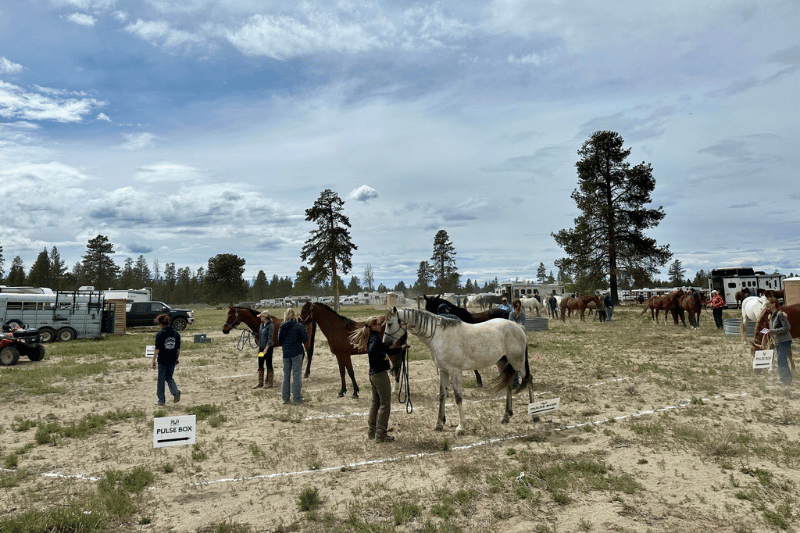
I set out mash, electrolytes, clothes, and breakfast. I ate a real dinner, thanks to Mr. Sweaty and his fabulolus pulled pork. We went to bed around 9:00. And, I actually slept. (Read about How to Get Better Sleep in Ride Camp.)
Morning arrived blessedly still after all the dusty wind of the previous day. Cloud cover had held in some heat, which meant donning summer-weight breeches and a Goretex rain shell for a 38-degree F start.
Atlas had slept, too, waking with a big smudge on his blanket and ears pricked for a bit of mash and alfalfa. He remained eerily calm for tacking up. And his warm-up walk. And mounting. And the two-minute countdown to start, which he spent eating grass while excited horses milled around us.
We left immediately at 5:00 a.m., without waiting for the field to get ahead, because I knew Atlas is naturally fast and figured we might as well save everyone the trouble of a lot of passing in the first few miles. He walked nicely on light contact until I asked for a trot, and off we went into the morning dusk.
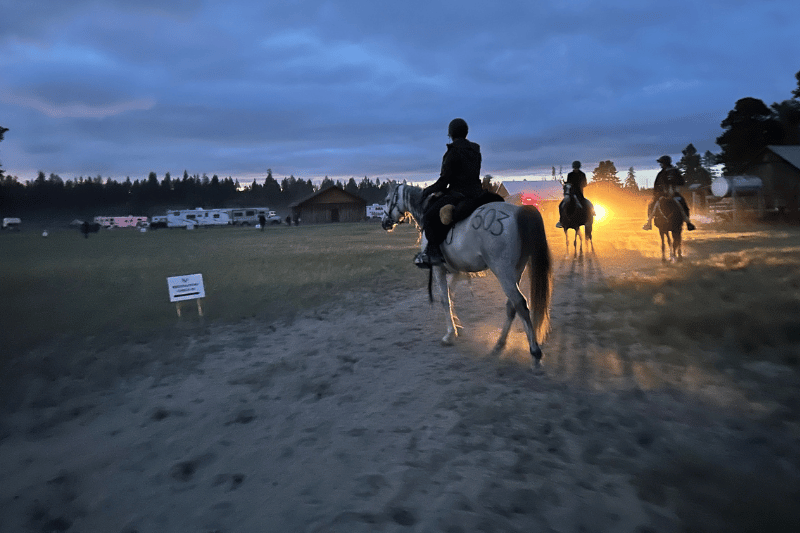
The first loop took us about 20 miles out and 2,000 feet up to a vet check at the intersection of some forest service roads. Atlas covered the miles easily. I negotiated with him on pace. We compromised on something brisk but reasonable, arriving in the out check before 7:30.
It was a bustling place, with horses and crew carving out tiny niches in which to throw blankets over hindquarters, syringe electrolytes, and eat. An astonishing 42 riders had started the 100 that morning. I’d been a little nervous about that, truth be told, but it presented an excellent opportunity to observe how Atlas would handle a crowded environment…which will, of course, be key at Tevis. He aced it.
Everything was going spectacularly! Now, I thought, the edge would be off Atlas’ energy and his adrenaline would be down, and we’d settle into a peaceful 80 miles to the finish.
Yeah…not so fast. (Or, more accurately, FASTER!)
We swung onto the trail for about 20 miles back to camp. Atlas knew the way from last year and wanted to speed up, but I was able to rate him with only minor protest. Everything went fine for 10 miles or so, until we arrived at a wooded water stop to find…a sheep.
A lone, freshly-shorn, nursing ewe stood near the water tank.
Atlas’ head went up, his eyes rolled, and his muscles bunched. Uh-oh. Not knowing him well and feeling he was about to bolt, I hopped off and kept hold of the rein as he tried to run. Thus restrained, he jigged instead.
No problem, I thought. We’ll just walk a little way down the trail until he settles. I’ll mount up and we’ll be on our way.
Solid plan, right?
But the sheep had other ideas. She followed us. Bleating hopefully, she trailed fifteen feet behind an increasingly-agitated Atlas, whose last brain cell had exploded all over the inside of his skull.
I realized my mistake: In getting off, I’d become recognizable to the ewe as a human. Desperate for food and safety, she wanted to come with me. And because I was on foot, she could keep up.
Ohhhhh, dear. There was nothing to do but keep going and hope the sheep would tire.
Meanwhile, a few groups of riders passed us. Several kindly offered to stick with me and Atlas while I got back on, and I did try, but he was too upset to do anything but zip around in high-headed circles. I sent the other riders on their way and kept walking. My new, wooley friend tagged along.
It took about two miles to ditch the sheep, but she finally got scared off by passing riders. Unfortunately, Atlas was now so mad about being held up the he couldn’t relax. All that nervous energy had turned him into an 800-pound champagne bottle, and I was the cork. I tried several times to get on, but every time I tried, more riders would come into view and upset Atlas again.
Finally, I intentionally took a wrong turn and found a quiet spot a quarter mile off trail. Drenched in sweat, I wrested off my rain shell and tied it to the back of the saddle while Atlas pranced circles around me. He wouldn’t stand, wouldn’t graze, wouldn’t chill out.
I waited for the smallest opportunity – a moment of distraction while he stared into the trees – and vaulted aboard. Finally! We were off!
Atlas charged back to the marked trail. He was now fully recovered, headed toward camp, and fighting mad. This was all-hands-on-deck riding, people. I checked my own heart rate at one point, and Garmin said it was 186. I actually believe that.
It wasn’t just the effort – it was adrenaline. Atlas had pulled out his old habit of head-tossing. You know, the type of head-tossing that caused him to fall and crush Layne’s leg in April. The type where you can see his nose between his ears and have no steering or brakes. SCARY.
I did my best to give him nothing to head-toss about. I pulsed the reins rather than pulling. I tried tipping his nose to one side. I used seat as much as possible. But Atlas was worked up, and he wasn’t coming down.
The good news was that he did stop to drink at every tank on the way to camp. The bad news was that he wanted to go faster and faster the closer we got.
At one point, I resorted to the kindness of another rider who let me use his horse as a bumper. That’s not the sort of behavior I normally recommend or approve of, but I was legitimately concerned that Atlas was about to break into a gallop down the hill and kill us both. Fortunately, the moment passed and we resumed our barely-restrained trot.
Those were harrowing miles, friends. I’ve never been so relieved to see camp come into view. Atlas saw it too, and I leaped off to lead him in from much further out than normal, because I knew he wouldn’t walk unless I did.
I can’t remember exactly what I said to Mr. Sweaty when he met us in the pulsing area, but it was something along the lines of “holy shit.”
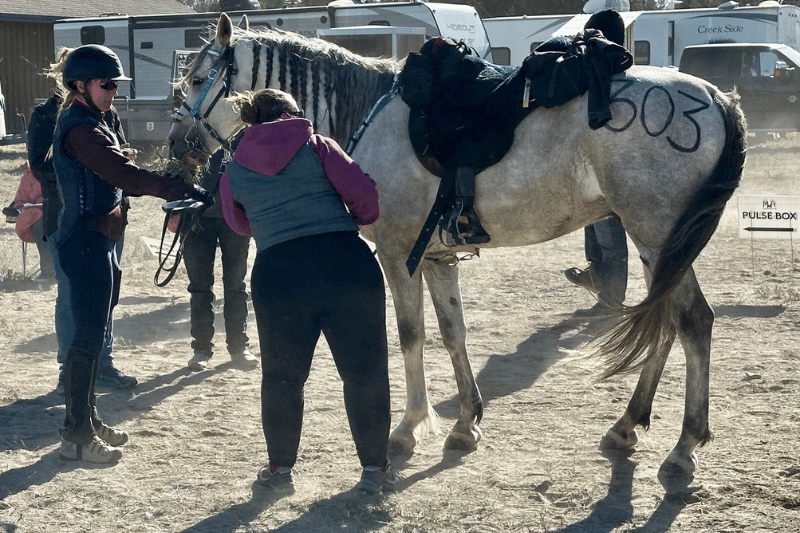
For his part, Atlas vetted well except for B and C gut sounds, which wasn’t entirely surprising since we’d just gone 40 miles. Mr. Sweaty got him eating right away while I tried to refuel myself and figure out my next move.
The obvious quick-fix would be a martingale, but Layne’s experience has been that Atlas responds to them with increased frustration. Given his behavior on the previous loop, I might have tried it anyway — except I realized that I didn’t have any rein stops along.
I decided to risk switching from his snaffle to the S-hack in which he’s done most of his miles, in case the bit was the problem. I packed the bitted headstall in a saddlebag, just in case, and after a 45-minute hold we were back on the trail.
Strangely, I wasn’t nervous. Surely he would be chilled out now, ready to settle into a steady trot for the remaining 60 miles!
Or not.
Atlas gobbled the next 23-mile loop like a candied carrot. We swept effortlessly along, stopping here and there to munch grass. “Slow” was not in the vocabulary. Atlas just isn’t a slow horse.
I let him take a pretty snappy pace, but it still wasn’t as fast as he could easily have gone. He let me know it with more head-tossing. Thankfully, things never got nearly as bad as they’d been on our way back to camp the first time.
I was still riding him every step of the way – no loop-rein, one-handed relaxation for us! – but I did manage to take in a water bottle full of the superfuel I’ve been testing for myself: 20 ounces of water mixed with one packet of LMNT electrolytes and a scoop of UCAN energy powder. (Heads up: TSE readers can get deals on both from my Offers Page!)
We made it back to camp feeling together and strong. Forty miles to go!
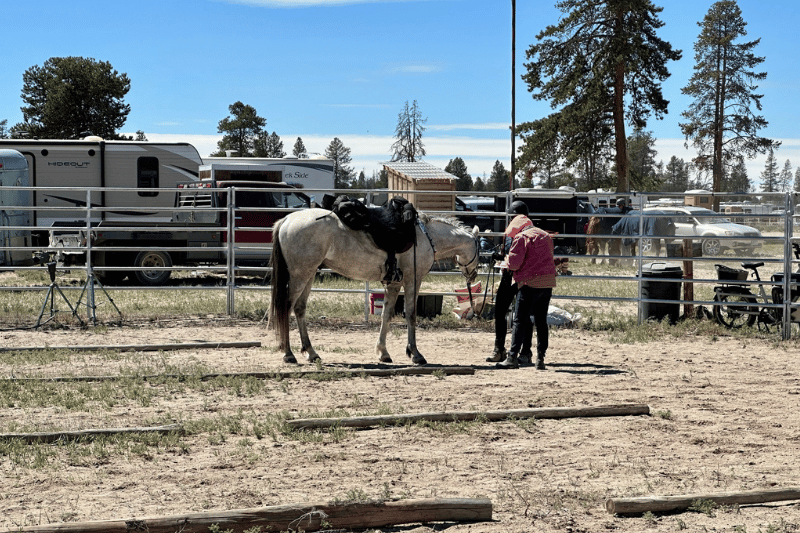
Atlas again vetted well except for low gut sounds. He had a voracious appetite and bright expression, however, so we carried on with watchfulness but not worry. The next loop was a mere 12-miler. We ate a lot of grass between speedy trots on the excellent footing, plus a few stretches of cantering to mix up the muscle groups.
When we returned to camp, the ride manager (also a friend of mine and Layne’s, and our Tevis crewing expert) asked how we were doing.
“He feels like I just got on him,” I said. It was true. Atlas’ gaits were effortless and elastic, as if we were five miles into a conditioning ride instead of 80 miles into a 100. And, his gut sounds were back to A’s. Huzzah!
The wind, which had been whipping all afternoon, seemed to pick up even more. Despite the warming sun, I changed into mid-weight breeches and a fresh base layer, right down to underwear and socks, in anticipation of nightfall. After a half-hour hold, Atlas and I waved to the camera for Layne – who was following us eagerly from home – and set out on another 10-ish mile loop.
Now, finally, it was time to let Atlas hit his stride. I let him settle into his preferred pace (which honestly, he probably could have maintained for a much larger percentage of the ride, but better safe than sorry) and marveled as he breezed along.
What fun! What a privilege to be out here, sweat-soaked and wind-torn, weary but strong, astride a young horse so in love with life!
Circling back into camp, we were finally able to walk (still mounted, for once) the final half-mile into the check. With the 42 starters all spread out by now, and some pulled, we were able to get a courtesy check right away.
At the previous two checks, Atlas had courtesy-pulsed at 68, dropping rapidly (within a minute) to 64, then 60. This time, he was already at criteria and we proceeded to the vet. They were thorough, lingering over gluteal muscles and pulling back the cinch to inspect for galls. All good.
Ten more miles!
We set off in daylight, but with our glowsticks cracked and headlamp ready. The air was chilly now – I’d even changed (yes, again!) into winter breeches and a down jacket in anticipation of cutting wind on the exposed ridges above camp.
Atlas clearly had his second wind – not that he’d used up his first one – and we rode that swinging trot right through dusk and into the night. By this point, I felt like we were really on the same page, flying along as a team of equals.
Blackness settled, and green lights swam into view to mark the trail. Yellow lights marked a couple barbed-wire gates, and I was grateful to have my head lamp to help me get Atlas through them safely.
By the time we reached the final three miles, I couldn’t see the trail at all. I let Atlas trot a bit – relatively slowly – but after a couple, minor stumbles, I asked him to keep it to his marching walk instead.
Was he grateful to slow down after 98 miles? Ohhhh, no. No, he was not. He complied, but reluctantly. I had plenty of horse to spare!
To get to camp, we had to pass through an area full of campers who were out to enjoy the Memorial Day weekend. Some had ATVs bristling with LED lights that blinded both me and Atlas, and a couple times I took him into the sagebrush and dismount to let them pass safely.
On the bright side, I was pleased to discover that riding in the dark caused me none of the dreaded nausea that sometimes befalls riders. I actually felt just fine as we hit the homestretch.
Camp had grown quite and dark. So dark, in fact, that Atlas and I lost a few minutes wandering around in the meadow looking for the finish line because we didn’t realize it had been moved into the vetting area after the front runners came through. It was too dark to see the unmarked gate, so we bumbled around a bit making sure we didn’t go through the fence that I knew was there somewhere.
Finally, at 10:34, in 12th place, we found our way to the huddle of vets and volunteers and handed over our ride card for the last time. Untack. Blanket. Gums. Skin. Guts. Trot.
“That was a great trot-out!” someone said. And just like that, we were done.
What a day. What a ride. What a horse!
Atlas settled into his blankets and an all-you-can-eat buffet. I showered and had some dinner before snuggling down to sleep – glad, so glad, that I never quite stopped dreaming.
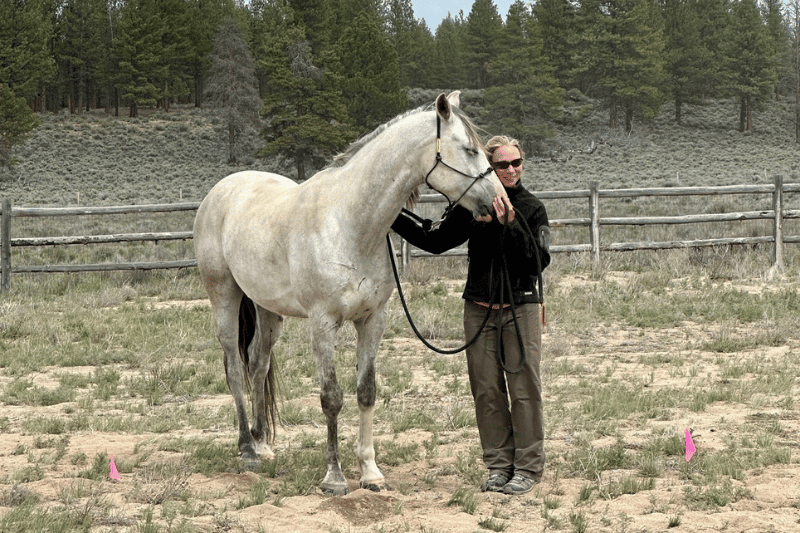
In the morning, we learned that both the 75- and 100-mile rides had enjoyed about an 80% completion rate. Management received much praise for excellent organization, and Atlas travelled home like a champ. I went down stairs sideways for two days (thanks for the quad workout, Atlas) and absorbed plenty of extra nutrition and sleep.
Layne finally got news of our completion after worrying until 4:30 a.m. (I didn’t have a cell signal in camp so other friends were providing updates, but none of them were around when we finished.) She wasted no time securing a trainer to put additional work into the head-tossing issue.
What’s next? We have our eye on a couple 50s at Strawberry Fields in June. That’ll test us with some climbing and altitude and sharpen Atlas up before Tevis. If all goes well, I’ll take my senior guy Jammer along for to ride a 50 on the third day.
But I’ve learned not to count on anything 100%. We’ll take the summer as it comes – all of us: Atlas, Jammer, Layne, and me – and make the best of whatever adventure it brings.
Come along for the ride!
Remember to subscribe to my newsletter and never miss a post!
You might also like
This post includes affiliate links, and I may earn a small commission (at no extra cost to you) when you purchase through these links. I only recommend products and services I think are helpful and useful. Thanks for helping me offset the cost of maintaining this blog as a free resource!

